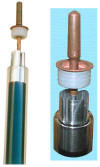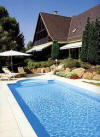|
| |
Solar water heating
EVACUATED TUBE SOLAR HOT WATER PANEL (20 tube)

These top-of-the-range solar panel heat collectors are suitable for heating
domestic hot water, swimming pools etc - even in the winter! One unit is
adequate for an average household (3-4people), and it is modular, so you can add
more if required. A single panel is sufficient for a 200litre cylinder, but you
can fit 2 or more for high water usage, or for heating swimming pools or
underfloor heating. Some types of renewable energy are only available in certain
locations, however free solar heating is potentially available to almost every
house in the UK! Every house should have one -really! And with an overall
efficiency of almost 80%, they are much more efficient than electric
photovoltaic solar panels (efficiency of 7-15%). And if we compare them on a
like-for-like basis, the price of a Solar Water Heater is around 30p/watt
(compared to £6+/watt for solar
This high tech unit concentrates the sun's energy at the tip of the copper 'heat
tube' - like a solid state magnifying glass!
  
The vacuum tube solar panel has been around for over 10years, and has proved to
be reliable and dependable. The vacuum tubes consist of a double wall glass tube
(made from strong borosilicate glass ie pyrex) with a space in the centre which
contains the heat pipe. The sun's radiation is absorbed by the selective coating
on the inner glass surface, but prevented from re-radiating by the silvered
innermost lining. This is in effect like a one-way mirror which has been
optimised for infra-red radiation. In fact it is very efficient, of the sun
light's energy hitting the tube's surface, 93% is absorbed, whereas only 7% is
lost through reflection and re-emission. The presence of the vacuum wall
prevents any losses by conduction or convection - just like a thermos flask.
Because of this, the system will work even in very low temperatures, unlike
traditional flat plate collectors. This is why our system can be used to heat up
water at the South Pole Antarctic Science Base - where ambient air temperatures
can drop below -40°C
The heat transferred to the tip of the heat pipe is in turn transferred to a
copper manifold in which water circulates to heat the domestic hot water tank.
If a tube is placed in direct sunlight on a summer day, the tip temperature can
reach 250°C - so the system easily heats domestic hot water cylinders to 60°C
even in cooler weather! The manifold is heavily insulated with a 2" thickness of
pre-formed rockwool to keep the heat in. Unlike flat plates, these headers are
so well insulated that they should not require antifreeze in normal operation -
the temperature of the header is unlikely to fall below 10°C even in very cold
weather. The more advanced solar controllers include a low-temperature facility-
should the temperature of the collector fall below a defined level, the pump
will operate to allow the the water at the bottom of the tank to heat the
collector slightly. In normal conditions, this would never be necessary - but it
acts as a good safety margin.
How Much Heat Will I Gain?
Average Daily Irradiation (Insolation) Figures for Each Month of the Year:
(Solar energy reaching each 1m2 of the earth’s surface at UK latitudes)
|
|
Jan |
Feb |
Mar |
Apr |
May |
Jun |
Jul |
Aug |
Sep |
Oct |
Nov |
Dec |
|
MJ/m2 day |
2.3 |
4.2 |
7.0 |
11.6 |
15.0 |
18.0 |
16.0 |
13.0 |
10.0 |
6.0 |
2.8 |
1.7 |
|
kWh/day per m2 |
0.64 |
1.17 |
1.94 |
3.22 |
4.17 |
5.00 |
4.44 |
3.61 |
2.78 |
1.67 |
0.78 |
0.47 |
|
Heat
Gain from 1 panel per day |
1.15kWh |
2.11kWh |
3.49kWh |
5.80kWh |
7.51kWh |
9.00kWh |
7.99kWh |
6.50kWh |
5.00kWh |
3.01kWh |
1.41kWh |
0.85kWh |
How Do I Connect the Panel?
 |
20 tube Solar Panel
Pressure Gauge
Air Vent (optional - these have a habit of failing - and the cheaper
ones will melt on hot days!)
Drain Cock
Expansion Vessel
Tap
Non-Return Valve
Double Check Valve
Filling Loop
Solar Circulation Pump
Pressure Relief Valve
Primary Coil
Secondary Coil
Overflow Pipe
Overflow Outlet (exterior)
|
Items 2, 5, 6, 8, 9, 11 can be purchased together as a Pressurised
System Kit
|
 |
Pressurised Systems.
The drawing above is one example of how to connect the panel. This is a typical
installation that would be carried out by a professional installer, utilising a
twin coil solar cylinder. These cylinders are far superior to a standard
domestic hot water cylinder - and I can supply these up to around 500litres
capacity! Typical solar cylinders are 175 - 260litres. The additional water
capacity allows the user to store heat for several days, to even out variations
in day-to-day isolation. The diagram above shows how the solar loop can be
operated as a pressurised system - this is almost universal for various reasons:
Ease of fitting
Not limited by headroom in the loft area
Most cost effective solution in terms of components and fitting time
Can allow operation above 100°C (eg if you run your system at 1bar, the water
will not boil until it reaches 120°C)
What else will I need to go with this panel?
It depends on your application and the method you employ. The simplest system
would be based on thermo-siphon (convection or 'gravity feed'). The panel would
be mounted lower than the hot water cylinder, when the sun shines, the hot water
will rise, and displace the colder water which returns to the panel. This system
requires no additional energy, no control system and is self-regulating, simple,
cheap and effective - but not very convenient for most situations. In this case,
you will only require the header tank or pressurised system kit plus copper tube
and insulation.
A typical system would normally include:
Solar panel
Solar Hot Water Cylinder
Pressurised System Kit
Controller and temperature sensors (Basic Resol B1 or Resol DeltaSol B
with display and additional control features
Pump and Isolation Valves
Non Return Valve to prevent siphoning (not absolutely necessary with evacuated
tube systems, but will increase efficiency slightly)
Copper pipework, fittings and pipe insulation (obtain from any good DIY or
Builders' Merchant)
 What about Swimming Pools?
What about Swimming Pools?
Swimming pools are an ideal application for solar water heating, as the
temperature required is quite low - under 30°C. Most installers will recommend
flat plates to keep the price down - because the amount of panels required is
much larger than for heating domestic hot water - however, if you can buy a high
efficiency evacuated tube solar panel for the same money - you might as well
enjoy solar heated pool water all year round - instead of just in July and
August! If you used flat plates, a rule of thumb for calculating what you need
is to fit the equivalent of 50% of the pool's surface area. For Vacuum tube
panels, this is reduced to 25% - and of course, they will carry on working in
the autumn, winter and spring. The Navitron panel is 2.25m2 so each panel will
heat 11m2 of pool area. A 40m2 pool would only need 4 panels . Compare
this to the cost of heating a pool for a year!
Installation is very simple. If you have chlorine you will need to fit a
stainless steel heat exchanger (this is because chlorine causes copper to
corrode). These are available from pool suppliers (they are needed for
conventional heating methods for the same reason). If you dont have chlorine,
you can simply put the solar panel in-line with the pool filter, so that the
pump directs water through the panel before returning it to the pool. As the
panel will NOT radiate heat on cold days, heat losses will be confined to your
pipe runs only - so you do not necessarily need a controller, although one can
be fitted, to control a 3-way solenoid valve to divert the water through the
panel when the panel is hotter than the pool water.
A Word on Flat Plates
Flat plate collectors only provide a useful amount of heat during the summer
months in the UK. due to their high heat losses during cold or windy weather.
When the ambient temperature drops, the heat loss can easily exceed the heat
gain - turning your flat plate solar collector into a radiator! The reason for
the popularity of flat plate collectors is their cheap construction - you can
build one yourself for a few pounds worth of scrap material, or you can buy one
for £300-500. This is typically a lot cheaper than evacuated tube panels, which
typically cost £800-1200.......until now! Don't fit a dinosaur!
Vacuum tube collectors will provide useful heat for 12months of the year, as
long as the sun is shining, and can even produce heat in overcast weather. (In
April, an overcast day without any sunshine is still able to heat a 210litre hot
water cylinder to 40°C)
A Word on Plastic Pipework
There are some flat plate systems for sale in the UK, such as the Solar Twin
system, which use plastic, silicone or rubber pipework, which makes
installations easier and to reduce costs. Whereas this pipework may be ideal for
flat plates, it is definitely not adequate for evacuated tubes. On a hot sunny
day, flat plates may heat water up to a temperature of 60°C. Evacuated tube
systems are capable of heating the water beyond 140°C. Most plastic pipework has
a working temperature of no more than 65°C, and is able to stand no more than
90°C - so you should always use copper for solar installations.
These are the basic features of the kit:
20 vacuum heat tubes with copper heat pipe and internal high efficiency heat
collector
1.5m tubes, 47mm diameter
Frame area of 2.25m2
Heat Reflectors which mount in the gap between tubes (to increase efficiency
further)
Full instructions (downloadable above)
Kit is supplied as two compact boxes (162x28x24cm, 172x18x27cm) which can easily
be transported in an average car
You can buy the other components from me, or from elsewhere - you chose!
Solar energy is the cleanest and most inexhaustible of all known energy sources.
Solar radiation is the heat, light and other radiant energy that is emitted from
the sun. The sun's energy, although plentiful, has been hard to directly harness
until recently.
Solar water heater converts solar energy into thermal energy, then heat the
water step by step. The beauty of this system is it does not create pollution or
harmful emissions, and is extremely economical - the fuel (sunshine) is free!
Plus, they are environmentally friendly. To take full advantage of these
heaters, you should ideally have an unshaded, south-facing location (a roof, for
example) on your property, although they can be utilised at ground level also.
This type of Solar water heater is now extremely popular in many areas of the
world, are are now becoming much more popular in the UK, due to their high
efficiency.
Until now, solar panels were not particularly popular in the UK due to their low
efficiencies during the spring, autumn and winter months. Classic solar panels
(flat plate collectors) work equally well as radiators - and therefore unless
ambient temperature is high, heat losses are considerable. Flat plate
collectors, despite their poor performance at UK lattitudes, have remained the
panel of choice until now, due to their low cost, and DIY-suitability. However,
we are now able to offer much higher efficiency vacuum tube collectors at
similar prices to flat plate collectors.
Key Benefits of Vacuum Tube Solar Panels:
High temperature output even in cold weather
Warms water even during winter, as long as the sun is shining
Produces heat even in overcast weather
Easy to fit
Higher efficiency and greater installation flexibility with heat to many of the
more expensive brands on the market - as the tubes and headers are all
manufactured in the same factory by an OEM supplier.
Panel ordering information. Note- We will not post these to you, we would
prefer you to either collect from us or arrange a carrier.
| |

|